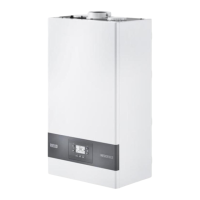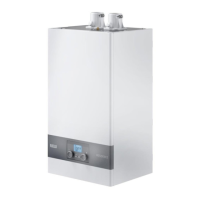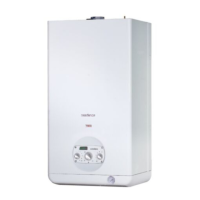37
INSTALLATION
2.12.1 Venting requirements
9
WARNING: Risk of system damage or personal injury!
The vent system could fail, causing ue gas leakage, resulting
in severe personal injury or death.
− Use only an approved vent starter coupling and approved
vent pipe from
R
− Do not mix components from different systems.
9
NOTICE: How to design the ue gas outlet
− Connect an oil-red unit to a vent having sufcient draft at
all times to ensure safe and proper operation of the unit.
The RTC Boiler is a category II or IV appliance and the exhaust
vent materials must be UL listed for use with a category IV appli-
ance: operating temperatures of up to 240 °F, positive pressure,
condensing ue gas. Currently, UL Listed vents of AL29-4C or 316L
stainless steel must be used with the RTC Boiler. Proper clearances
to combustibles must be maintained per UL and vent manufac-
turer instructions.
The specifying engineer should dictate ue venting as appropriate
to the installation.
The vent system should be designed to facilitate smooth travel for
both the intake and exhaust. Avoid the use of bullhead tees and
back-to-back 90 degree elbows. The exhaust system must never
be installed in a downward fashion. Be sure to follow all instruc-
tions provided by the vent manufacturer.
Keep the supply of combustion air free of corrosive substances
(e.g. halogenated hydrocarbons that contain chlorine or uorine
compounds). This will help prevent corrosion. Never use or store
chlorinated cleaning agents or halogenated hydrocarbons (as
contained in spray cans, solvents or cleaning agents, paints and
adhesives, for example) in the boiler room.
UL, NFPA 54 & 211, ANSI Z223.1 and CSA B149.1 guidelines are often
the basis for state and local codes. Follow the guidelines of these
recognized agencies unless codes applicable to the installation
site are most stringent. The venting and combustion air systems
must meet all applicable code requirements. Where code differs
from the instructions provided with the equipment, code will take
precedence.
Constant pressure at the ue gas outlet is not required. Size the
ue system to limit pressure variations. The maximum allowable
breech pressure for design of the ue system is positive 0.2" W.C.
for proper combustion and light off.
A draft control system may be required to ensure proper draft
when two or more boilers are connected to a common stack. Con-
sult the ue material manufacturer for design calculations and
recommendations.
2.12.2 Code required vent terminations
Horizontal Terminations:
− Vent terminations should be at least 4 feet below, 1 foot
above or 4 feet horizontally from any window, door or
gravity air inlet of a building.
− The termination shall be at least 6 feet away from any other
building opening, gas utility meter, service regulator or the
like.
− The termination shall be at least 6 feet away from the com-
bustion air intake of any other appliance.
− The bottom of the vent terminal should be at least 12 inch-
es above both nished grade and any snow accumulation
point.
− Vent should not terminate over public walkways or over an
area where condensate or vapor could create a nuisance or
be detrimental to the operation of regulators, meters and
other equipment.
− Discharges should not be in wind-blocked areas, corners,
or directly adjacent to vegetation.
Vertical Terminations:
− Roof penetrations should follow all appliance codes and
the vent manufacturer‘s instructions. The vent should
never be installed at less than the required clearances to
combustible materials per UL, NFPA and local codes. “Dou-
ble-wall or thimble” assemblies are required when pene-
trating combustible walls and roofs.
− Vertical discharges should extend at least 2 feet above the
roof through properly ashed penetrations and at least 2
feet above anything within a 10 foot horizontal diameter.
Discharges that extend more than 2 feet above the roof
must be laterally supported.
− If the vent systems is to be connected to an existing stack,
the stack must be UL Listed for Category II or IV appliances
(capable of 240 °F, positive pressure and condensing ue
gas operation).
− Masonry stacks must be lined and the vent penetration
must terminate ush with and be sealed to this liner. Vents
may enter the stack through the bottom or side.
− RTC Boiler vent systems must not be interconnected to any
other venting system; The RTC Boiler is designed to main-
tain its own vent system.
− The exhaust vent must be pitched up toward the termina-
tion a minimum of 1/4 inch per foot of length. Condensate
must ow back to the boiler ue collector freely, without
accumulating in the vent.

